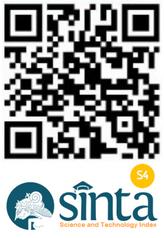GROWTH RATE AND UTILIZATION RATE OF PELAGIC FISH COMMODITY IN THE COASTAL OF INDRAMAYU REGENCY, WEST JAVA
Abstract
Economic valuation is needed to analyze the economic function of ecology against direct and indirect benefits for ecosystem services and natural resources. The aim of this research is to estimate the total economic value of an ecosystem in an area, which is expected to be analyzed from a public point of view as one of the important parameters in an economic analysis. Respondents consist of fishermen and economic actors who are located in the coastal study area in Indramayu Regency using the snowball sampling technique. Data analysis uses an economic valuation technique approach to calculate the total economic value of fishery resources. The results showed that in the mangrove ecosystem the actual value was lower in the form of the remaining green bag fragments. On the other hand, the coral reef ecosystem in the observation area still shows good results. And in the pelagic fish ecosystem, the composition of the species caught the most in the area include ponyfish, treadfin bream, goatfish, tuna, sardines, and mackerel with observations on the exploitation rate showing that overfishing has not occurred in Indramayu waters.
Downloads
References
[Direktorat Jendral Perikanan]. 1996. Buku pedoman pengenalan sumber perikanan laut. Jakarta (ID): Ditjen Perikanan Departemen Pertanian.
Effendie MI. 2002. Biologi Perikanan Bagian I, Studi Natural Histori. Bogor (ID): Institut Pertanian Bogor.
Gayanilo, F.C.Jr., Sparre, P. & Pauly, D. 1994. The FAO-ICLARM Stock assessment tools (FISAT) user guide. FAO Computerized Information Series (Fisheries), FAO, Rome. 7: 186.
Gulland, J.A. 1971. The Fish Resources of the Ocean. England (UK): Surrey, Fishing News Books Ltd.
____________. 1983. Fish Stock Assessment: Manual of Basic Method, 1 FAO/Wiley Series on Food and Agricultural. New York (US): Wiley and Sons Inter-science.
King, M. 1995. Fishery Biology, Assessment, and Management. London (UK): Fishing News Books.
Merta, I.G.S., Subhat, N. & Widodo, J. 1998. Sumberdaya Perikanan Pelagis Kecil. Di dalam: Widodo J, Kiagus AZ, Bambang EP, Tampubolon GH, Nursali N, Djamali A, editor. Potensi dan Penyebaran Sumberdaya Ikan Laut di Perairan Indonesia. Jakarta (ID): LIPI.
Pauly, D. 1980. On the relationships between natural mortality, growth parameter, and mean environmental. Jurnal Penelitian Perikanan lndonesia. 39(2): 175-192.
_________. 1982. Studying single species dynamics in multispecies context, theory and management of tropical fisheries. In D Pauly and GI Murphy (eds). ICLARM Conference Proceeding 9. 33-70.
_________.1984. Fish population dynamics in tropical waters: a manual for use with programmable calculators. ICLARM Stud Rev. 8: 325.
Sparre, P. & Venema, S.C. 1999. Introduksi Pengkajian Stok Ikan Tropis. Terjemahan Pusat Penelitian dan Pengembangan Perikanan. Jakarta (ID): Buku Manual I.
Uktolseja, J., Purwasasmita, R., Susanto, K. & Sulistiadji, A.B. 1998. Sumber daya ikan pelagis besar. Dalam: Widodo J. 1998. Potensi dan penyebaran sumber daya ikan laut di perairan Indonesia. Komisi Nasional Pengkajian Stok Sumber Daya Ikan Laut-LIPI. 251.







